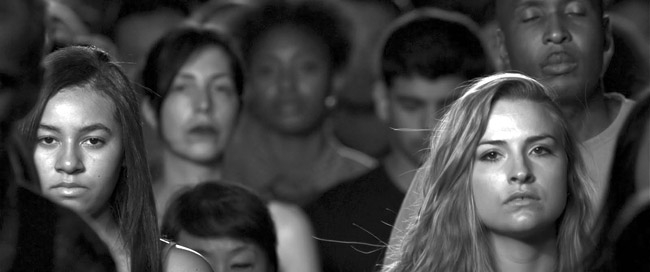The Visitors
David Ulrich
Photographer, core faculty and program coordinator for Pacific New Media at UH
Overall, what did you think?
The movie is a series of “moving stills” shot with gorgeous black-and-white tonalities that become an extended meditation about humanity, nature and the imbalances wrought by technology. A purely visual and audio statement, there’s no plot, no dialogue and an ambiguous message conveyed strictly through metaphor and symbolic imagery. The visual vignettes were striking though indulgent, with the filmmaker lingering on each of the 74 scenes in a manner that is meant to be highly visceral. It’s a film for grown-up attention spans and moves very slowly, staying on single frames for minutes, not seconds.
What was one of your favorite scenes?
The abandoned amusement park becomes one of the strongest metaphors in the film, especially the decaying clown statues. They are weirdly provocative and, for me, represent the dangers of a highly superficial approach to life promulgated by media and popular consumer culture.
On a scale of one to four stars, what would you rate this film?
★★ 1/2
What did you think of the cinematography?
The visuals and post-production effects are stunning, though many of the metaphors seem too obvious for my sensibilities. The use of infrared effects in many of sequences, though beautiful, seemed dated and a bit of a cliche. The myriad faces portrayed in the film are haunting and stare back at the viewer, wordlessly, mostly without overt facial expressions or blinking. On the big screen, the images are powerful and compelling, though disjointed without obvious connections.
What are your thoughts on the message?
Similar to Godfrey Reggio’s earlier film Koyaanisqatsi, the themes revolve around the alienation and imbalance of modern life. In Visitors, people seem to stare at us from the big screen, but as the film develops it becomes clear they are viewing their own screens of digital devices, video games and entertainment. The film takes us on an evolutionary journey from the moon to the apes to the decline of humanity – and back to the moon. The film purports to offer a humanitarian and environmental message on the impact of technology on our lives. However, I don’t think the message was well-articulated or clearly developed.
To whom would you recommend this movie?
It’s a niche market of those interested in photography and art films.
Did the soundtrack contribute significantly to the film?
For me, the beauty of the film was the interaction between the visuals and the exquisite musical score by Philip Glass. The synergy between the imagery and the music was breathtaking. The music of Glass, and how it flowed seamlessly with the visuals, was the strongest aspect of the film.
Would you watch this movie again?
I’m conflicted. The black-and-white imagery was truly stunning, but I’d be hard pressed to identify a recognizable development of the theme. It’s a great idea that I hope can be advanced by other filmmakers. So, probably not.
On a different note, what’s new with you?
We’re excited about our spring and summer series of workshops and our upcoming juried photography show opening April 11 at Andrew Rose Gallery, “Contemporary Photography in Hawaii: The Sixth Annual Survey Exhibition,” sponsored by Pacific New Media.






